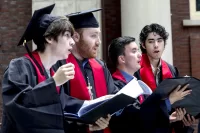
Selected from the largest applicant pool in Bates history, the 501 members of the Class of 2023 arrive at Bates on Monday, Aug. 26.
As they settle into various campus abodes on Opening Day and kick off their nine-day Orientation, the new students are embarking on a Bates journey that, in a conventional sense, has a specific terminus: Commencement four years hence, on May 28, 2023.
In another sense, a Bates journey is timeless, a mindset that lasts “for as long as they wish,” says Professor of Sociology Emily Kane.
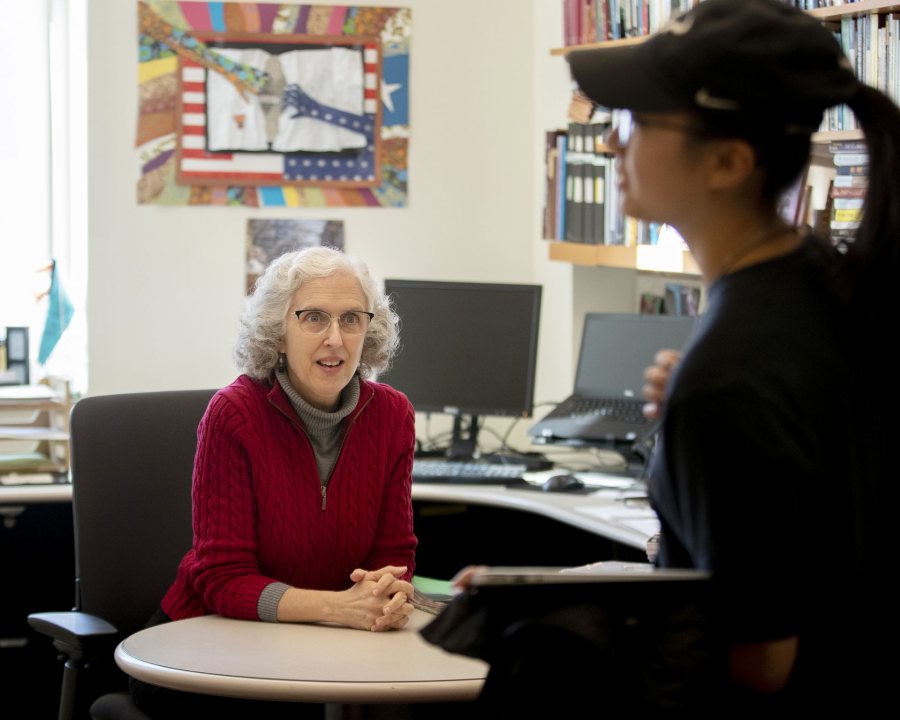
In her Pettengill Hall office, Professor of Sociology Emily Kane wraps up a meeting with Hermione Zhou ’21 last January. (Phyllis Graber Jensen/Bates College)
While regular classes don’t begin until Sept. 4, Orientation offers a taste of Bates academics right off the bat. So on Tuesday morning, the day after they arrive, the new students will attend their very first class, specifically their First Year Seminar.
This fall, Kane is teaching one of the seminars, “Inequality, Community, and Social Change.” A few days ago, as Kane was preparing for Tuesday’s first class gathering, she was also exchanging emails with a former student, now in graduate school, who took her First Year Seminar six years ago.
+Class of 2023 by the Numbers
Demographics
Total class size: 501
Female: 54% (270)
Male: 46% (231)
U.S. students of color: 28%
First generation to college: 12%
Public school: 50%
Independent or parochial school: 50%
Non–U.S. citizens: 8%
Geographic
New England: 39%
Middle Atlantic: 25%
Midwest: 5%
Southeast: 5%
Southwest and West: 16%
Outside U.S.: 10%
Countries represented: 24, including the U.S.
Australia, Canada, China, El Salvador, Estonia, Ghana, India, Ireland, Japan, Kenya, Latvia, Macau S.A.R., Mexico, Nicaragua, Niger, Pakistan, Russia, Senegal, Singapore, South Korea, Thailand, Turkey, and the United Kingdom.
Financial Aid
Total grant aid: $9.6 million
Receiving Bates grant aid: 41%
Average Bates grant: $47,051
“She was writing to say she’d come across a recent book chapter I wrote,” Kane explains, “and was finding it useful in her own graduate work on family policy.”
That moment — communicating about academics with an alumna while simultaneously preparing for new students — left Kane dazzled “by all those connecting threads. That’s what I hope to convey on the first day of class: the excitement and possibility and world of new connections that Bates offers.”
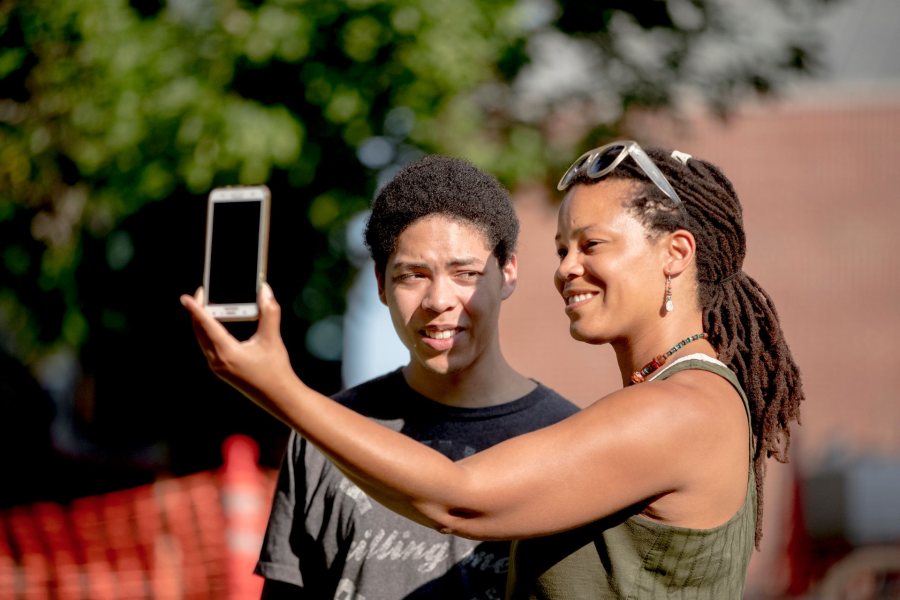
Jamari Amrham ’22 of Richmond, Calif., has his eyes on his mom, Cherie Hill, as she took a selfie during Opening Day in 2018. (Phyllis Graber Jensen/Bates College)
All across campus, Bates has its arms open to the new students, ready to help them make the best of these transformational four years.
“Orientation introduces students to the Bates people, programs, and resources that will give them the tools to succeed,” says Assistant Dean of Students Blake Reilly, who oversees Orientation.
“We want our newest students to know that there’s always someone to turn to for support — and, hopefully, it’s someone they will have already met at Orientation.”
Orientation, which also features three days of student-led outdoor trips throughout Maine and New Hampshire, concludes next Tuesday with Convocation, the official opening of the academic year.
This year’s Convocation features an address by Dolores Huerta, a labor activist and civil rights icon who co-founded the United Farm Workers of America. The subject of an eponymous documentary that is this year’s Commons Read, Huerta will receive a Bates honorary degree at Convocation.
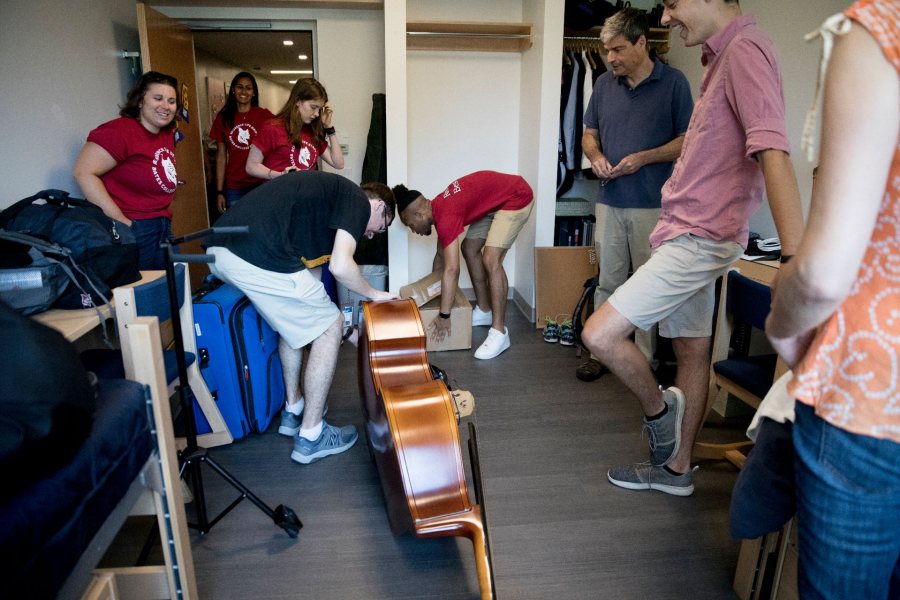
On Opening Day, as seen in 2018, new students get many helping hands from student members of the college’s Residence Life staff. (Phyllis Graber Jensen/Bates College)
The metaphorical arms welcoming the new class include those of the beloved, college-run Dining Services, fully ready to welcome the newest students on Monday evening for their very first meal in Commons.
“Whether a student has had a great day or a lousy day when they come through our doors, we have an opportunity to make their experience excellent.”
Among other items, the first dinner will feature salmon piccata; barbecue seitan with veggies; a variety of pastas and sauces, including marinara, alfredo, pesto; and squash and crab bisque made from scratch, as all soups are at Bates — not to mention fresh tomatoes and kale from the college’s vegetable garden, the Plot, run by student EcoReps.
As prior generations of Bates students have discovered, dining at Bates — distinctive for its single dining hall — is about great community and great food. “We want our new students to understand that this is a fun place and a comforting place — their home away from home,” says Director of Dining Cheryl Lacey.
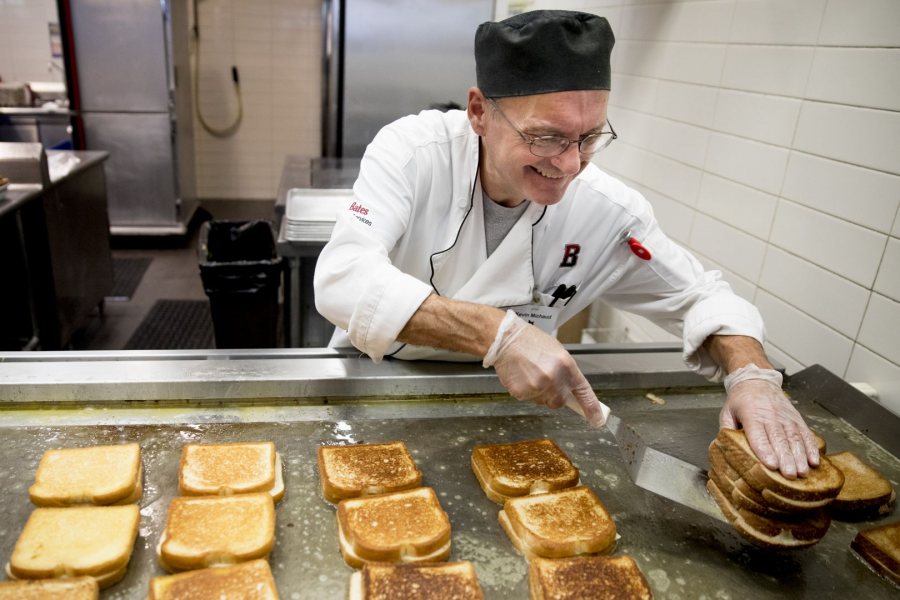
Community and comfort are on the menu for the Class of 2023 at Dining Services, where Kevin Michaud prepares grilled cheese sandwiches for a recent Friday lunch. (Phyllis Graber Jensen/Bates College)
A meal at Commons gives students a chance to press the reset button, she says.
“Whether a student has had a great day or a lousy day when they come through our doors, we have an opportunity, at each point of service, to make their experience excellent.”
Students “should always feel comfortable approaching any of us to ask questions. They should feel comfortable building connections with our chefs, which they do, year after year, and asking questions about their food.”
Pursuant to answering food questions, Bates recently became one of the few liberal arts colleges nationally to offer a mobile-friendly online nutrition guide for every dish on the Dining Services menu.
Continued national and international geographic expansion is “imperative.”
The 501 students arrive Monday thanks to the work of the Admission team, which reviewed a record-setting 8,222 applications this year.
“There’s excitement for Bates right now — students and families really desire a Bates liberal arts education,” Weisenburger says, pointing to strengths like Purposeful Work, highly relevant and interdisciplinary academics, a location in Lewiston and in Maine, and a “community where students are recognized and celebrated as individuals.”
The new class features historic strengths, including 28 percent U.S. students of color, the highest ever, and a continued demographic-driven expansion to the West and South.
+A Few Facts About Students in the Class of 2023
In their applications and conversations with the Bates Admission team, members of the Class of 2023 shared fascinating facts about their interests and accomplishments in high school. Such as:
- Receiving a $5,000 grant to fund tech upgrades for their school.
- Serving as a student delegate to the United Nations’ 63rd Commission on the Status of Women.
- Working to pass new bylaws in their hometown banning point-of-purchase plastic bags and single-use plastic bottles.
- Founding a culture show that donated $10k in proceeds to a local nonprofit.
- Being the youngest finisher of the famed White Mountains 100, a winter bike race across 100 miles of Alaska’s interior.
- As a member of the Park and Recreation Commission in their Minnesota hometown, writing the program justification for a piano-in-the-park event.
- Conducting research on shrimp population change.
- Exhibiting at the Museum of Modern Art.
- Owning a business delivering firewood.
- Building their own tiny house.
- Besides excelling in field hockey, playing flag football internationally.
- Working as a zoo interpreter for bears and flamingos.
- Performing on the violin with Yo-Yo Ma.
- Becoming an accomplished magician who performs at parties and fundraisers.
- Working as a product tester for New Balance.
- Founding a nonprofit that create shopping bags from old T-shirts to help reduce plastic-bag use.
- Working extensively with homeless youth.
- And performing at national levels in volleyball, debate, archery, and Nordic skiing — plus birding and yodeling.
As recently as 2009, 50 percent of the incoming class was from New England. This year’s class is 39 percent, even as Bates maintains its firm commitment to Maine students. Similar to prior years, Mainers represent 9.6 percent of the class.
Continued national and international geographic expansion is “imperative,” explains Weisenburger, as high-school-age populations in the Northeast decline.
“Bates continues to invest in diversifying and strengthening our applicant pool,” says Weisenburger. “And that’s not the same as merely growing the pool. Our goal is to attract the most diverse and talented applicants possible, while staying true to Bates and enrolling students who really want to be here.”
+The 2019 Admission Season by the Numbers
Total applications: 8,222
A Bates record, the application total is 7 percent more than last year’s total, also a record.
Total admitted: 998
The percentage of students admitted is a record 12.1 percent. That’s the lowest rate — meaning the most competitive — in Bates history.
Total class size: 501
Bates’ overall yield rate, a measure of a college’s desirability in the marketplace, is a record 47.4 percent, meaning nearly one of every two admitted students chose to matriculate. (The yield calculation does not include 28 first-year students admitted in 2018 who chose to take a gap year.)
There’s strength in numbers, she adds. “Bates is in a very competitive higher-education environment. From that competitive standpoint, Bates is where we need to be.”
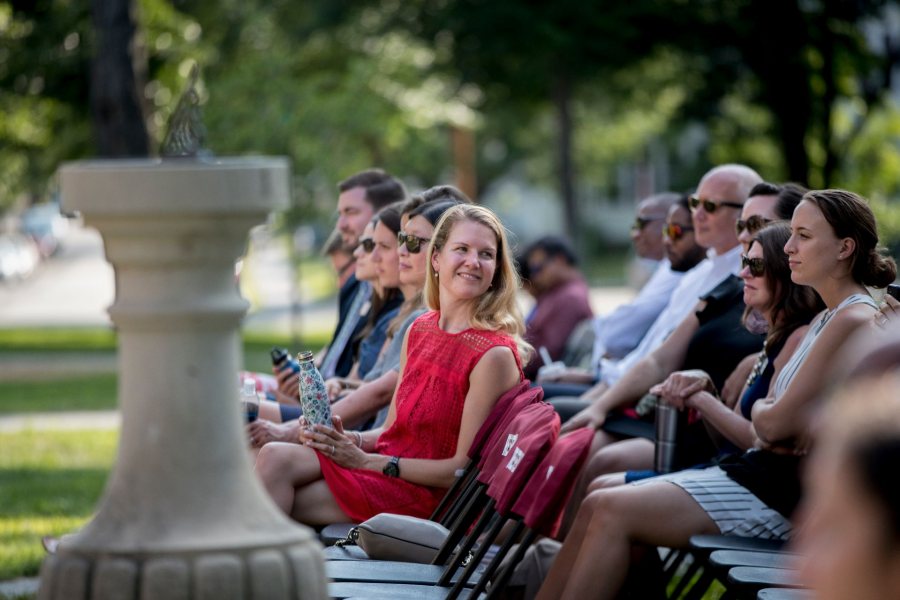
“Bates continues to invest in diversifying and strengthening our applicant pool,” says Dean of Admission Leigh Weisenburger, seen in 2018 on Opening Day for the Class of 2022. (Phyllis Graber Jensen/Bates College)
In terms of academic strength, “the numbers speak for themselves,” she says, noting an average GPA of 3.73. “Beyond the numbers is the high level of curiosity these students have, regardless of their high school background. The way they want to learn and the questions they want to ask — that’s what really excites me.”
On Opening Day, Weisenburger will join President Clayton Spencer for an end-of-day event with all new students and parents. Weisenberger’s message? “Just take a moment to celebrate. Take a deep breath, and enjoy the moment.”
